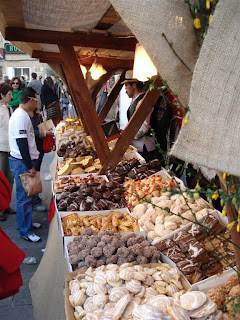The time of Carnival is upon us, held before the days of Lent. It's a time of feasting and practical joking, a time to let your hair down, to break from conformity of everyday life. Now everyone knows the biggest Carnival is in Rio de Janeiro, but to get back to where it all began one needs to travel to another continent, to another time, before Brazil before the Americas.
The Carnival we see today dates back to the middle ages, but it's origins can be traced back even further, to pagan times. The word Carnival comes from Italy, where they call it Carnevale that literally translated means "end of meat" as the consumption of meat is forbidden during Lent, so the few days before are a time for gorging and feasting!
Started by the followers of Catholicism it soon spread throughout Catholic Europe, with each nation putting it's own regional spin on the event. Here in Galicia the small town of Xinzo de Limia is home to the longest Carnival in Spain.
In Galician the Carnival is referred to as the Entroido and runs for approximately seven days. During these day's people take to the streets in fancy dress. Men will be dressed as women and vice versa. Children to take part in the festivities, with nurseries to schools having their own fiestas, encouraging participation, children can be seen walking to school in fancy dress with painted faces, loving every minute of it!
In Vigo the Entroido started on the evening of Thursday 31st with the major organised events being put on by the Council. Plaza de Constitution was the focal point for the first night, beginning with a round of impromptu song, the idea here is to sing what you like, with out fear of being hung drawn and quartered! It's all just for fun after all!
Also we see 'El Meco' which this year takes the form of a horse, representing a social or political issue, this year is PXOM who are responsible for urban planning, they were caught up early in the year trying to bulldoze a families house but paying less attention to two multimillion euro apartment blocks built with no planning permisson, among other things.
El Meco is crowned and placed on the throne, then on Tuesday will be put on trial, and be accused of bringing ill to the city over the past year. The Friday night saw more of the same but with more music and dance.
On Saturday night was a Mardis Gras parade with floats and musical performances, fancy dress and traditional Galician dress, this masqueraded it's way through the streets, very colourful indeed, more reminiscent of the Carnival in Rio de Janeiro! Thousands were out lining the streets, enjoying the spectacle! Sunday was for the children with many activities including bouncy castles, costume making, puppet shows and more... just one big party for kids!
Monday evening was events for bigger kids and a Festival of Folk, which put a more Galician twist on events. With traditional dance and music, the sound of gaiters (bagpipes) filling the night air, stirring the Celtic side of me!
On Shrove Tuesday 'El Mecos' time is up. Onlookers gather at the Praza do Rei to listen to the charges, a mock trial ensues but with a flimsy defence El Meco is sent to the flames, witnessed by thousands of on lookers.
Ash Wednesday and it's time for the mourners to come and once again the people of Vigo turned up in their thousands to witness the burial procession. Starting from Paseo Alfonso XII and winding it's way down Vigo's 'Golden Mile' before taking a left and heading down to the port before concluding at the Estacion Maritima. Crying could be heard from the procession from those who lament poor El Meco. One last testament is read to El Meco and then with fireworks overhead brings a close to Entroido 2008.
All in all a very well organised event and a lot of fun had by all who attended, although the usual gripes were heard from the usual corners, such as, blocked streets, traffic jams, an increase in the amount of people double parking...etc... Definitely looking forward to next years spectacle.
Just a quick note: Another event took place on Sunday 3rd February, that was slightly overshadowed by the Carnival and that was the day of San Blass, the Patron Saint of Drunks and Unions... that's definitely one for another blog!!!
.jpg) A recent statistic came to light, after an accident involving two elderly woman on a pedestrian crossing last week. In Vigo, you have just as much chance of being hit by a vehicle on a pedestrian crossing, as you have in crossing the road at any other place. The two woman in question were crossing on a controlled cross, the light was red for traffic and green for them, they were seriously injured with multiple fractures.
A recent statistic came to light, after an accident involving two elderly woman on a pedestrian crossing last week. In Vigo, you have just as much chance of being hit by a vehicle on a pedestrian crossing, as you have in crossing the road at any other place. The two woman in question were crossing on a controlled cross, the light was red for traffic and green for them, they were seriously injured with multiple fractures.

.jpg)

.jpg)
.jpg)
.jpg)
.jpg)
.jpg)
.jpg)
.jpg)
.jpg)
.jpg)
.jpg)
.jpg)
.jpg)
.jpg)

























